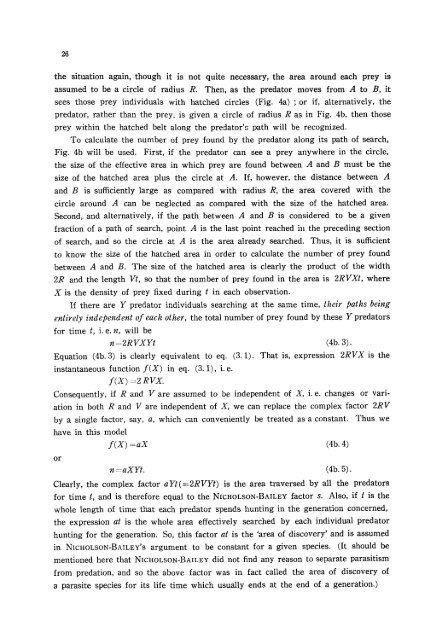A comparative study of models for predation and parasitism
A comparative study of models for predation and parasitism
A comparative study of models for predation and parasitism
Create successful ePaper yourself
Turn your PDF publications into a flip-book with our unique Google optimized e-Paper software.
26<br />
the situation again, though it is not quite necessary, the area around each prey is<br />
assumed to be a circle <strong>of</strong> radius R. Then, as the predator moves from A to B, it<br />
sees those prey individuals with hatched circles (Fig. 4a) ;or if, alternatively, the<br />
predator, rather than the prey, is given a circle <strong>of</strong> radius R as in Fig. 4b, then those<br />
prey within the hatched belt along the predator's path will be recognized.<br />
To calculate the number <strong>of</strong> prey found by the predator along its path <strong>of</strong> search,<br />
Fig. 4b will be used. First, if the predator can see a prey anywhere in the circle,<br />
the size <strong>of</strong> the effective area in which prey are found between A <strong>and</strong> B must be the<br />
size <strong>of</strong> the hatched area plus the circle at A. If, however, the distance between A<br />
<strong>and</strong> B is sufficiently large as compared with radius R, the area covered with the<br />
circle around A can be neglected as compared with the size <strong>of</strong> the hatched area.<br />
Second, <strong>and</strong> alternatively, if the path between A <strong>and</strong> B is considered to be a given<br />
fraction <strong>of</strong> a path <strong>of</strong> search, point A is the last point reached in the preceding section<br />
<strong>of</strong> search, <strong>and</strong> so the circle at A is the area already searched. Thus, it is sufficient<br />
to know the size <strong>of</strong> the hatched area in order to calculate the number <strong>of</strong> prey found<br />
between A <strong>and</strong> B. The size <strong>of</strong> the hatched area is clearly the product <strong>of</strong> the width<br />
2R <strong>and</strong> the length Vt, so that the number <strong>of</strong> prey found in the area is 2RVXt, where<br />
X is the density <strong>of</strong> prey fixed during t in each observation.<br />
If there are Y predator individuals searching at the same time, their paths being<br />
entirely independent <strong>of</strong> each other, the total number <strong>of</strong> prey found by these Y predators<br />
<strong>for</strong> time t, i. e. n, will be<br />
n-:2RVXYt (4b. 3).<br />
Equation (4b. 3) is clearly equivalent to eq. (3.1). That is, expression 2RVX is the<br />
instantaneous function f(X) in eq. (3.1), i.e.<br />
f(x) :2 RVX.<br />
Consequently, if R <strong>and</strong> V are assumed to be independent <strong>of</strong> X, i.e. changes or variation<br />
in both R <strong>and</strong> V are independent <strong>of</strong> X, we can replace the complex factor 2RV<br />
by a single factor, say, a, which can conveniently be treated as a constant. Thus we<br />
have in this model<br />
f(X) -aX (4b. 4)<br />
or<br />
n =aXYt. (4b. 5).<br />
Clearly, the complex factor aYt(=-2RVYt) is the area traversed by all the predators<br />
<strong>for</strong> time t, <strong>and</strong> is there<strong>for</strong>e equal to the NICHOLSON-BAILEY factor s. Also, if t is the<br />
whole length <strong>of</strong> time that each predator spends hunting in the generation concerned,<br />
the expression at is the whole area effectively searched by each individual predator<br />
hunting <strong>for</strong> the generation. So, this factor at is the 'area <strong>of</strong> discovery' <strong>and</strong> is assumed<br />
in NICHOLSON-BAILEY'S argument to be constant <strong>for</strong> a given species. (It should be<br />
mentioned here that NICHOLSON-BAILEY did not find any reason to separate <strong>parasitism</strong><br />
from <strong>predation</strong>, <strong>and</strong> so the above factor was in fact called the area <strong>of</strong> discovery <strong>of</strong><br />
a parasite species <strong>for</strong> its life time which usually ends at the end <strong>of</strong> a generation.)















